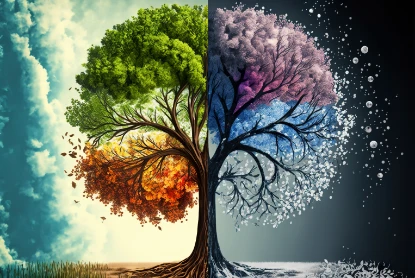If you knew you couldn’t fail, what would you do differently?
The odds were stacked against them. 100,000 people in attendance and they would be battling against other bands including Ozzy Osbourne and The Scorpions. This was the one-armed drummer’s moment, but could he pull it off?
Def Leppard have since sold over 100 million albums. The story of their drummer, Rick Allen, is one of persistence, and hope.
“Life isn’t what happens to you, it’s how you respond.” Rick Allen
Why am I talking about a rock band, you may ask? Their story speaks to the power of the mind and what we are all capable of when we don’t give up.
In this article, we’ll talk about:
- Cycles of emotional change
- Why change is hard
- Tips to help you change
The rollercoaster of change
Jason Capital describes 5 cycles of emotional change explained in the table below.

| Cycles of change | Thoughts | State of Mind |
|---|---|---|
| Uninformed Optimism | “I can start my own business, work my own hours and make money. This will be easy.” | Excitement |
| Informed Pessimism | “This is way harder than I thought, I’m not sure I can do this.” | Frustration, Anxiety, Fear |
| Valley of Despair | “This is impossible! I can’t do this. I’m not smart enough.” | Hopelessness, Procrastination, Negativity |
| Informed Optimism | “This is hard but I can do it.” | Hope, Positive |
| Success & Fulfillment | “I’m stronger than I thought. I did it and it was so worth it.” | Confidence, Empowerment |

Let’s talk about each cycle in a little more detail.
Uninformed Optimism: In this initial stage, we find ourselves excited at the prospect of what we are about to embark on. We tend to see the situation as simpler and easier than it truly is, and are unaware and uninformed about the path that lies ahead. If we were on a rollercoaster this would be the part where we are slowly moving up, seeing the ground below getting smaller and smaller. We are eager, a little nervous, and excited with anticipation.
Informed Pessimism: This is when we start to realize that it’s not as easy as it looks (to change, to learn, or grow). We start to feel anxious that perhaps we didn’t think it through enough. We start to feel afraid that maybe we can’t complete this journey that we’ve embarked on. And we also feel frustrated that it’s taking so long! This would be the point on the rollercoaster where we’ve reached the top, and looking down from this great height, exclaim ‘Oh, crap, I’m not sure about this anymore!’
Valley of Despair: This is the turning point. This is where we either turn around, and give up or push forward. This is the stage where 90% of people stop, hit a wall and decide they can’t go on. As the title of the stage suggests, it is characterized by feeling negative, hopeless, and doubtful. This is where all those thoughts like “I can’t do it, I’m not good enough” surface. This is the point on a rollercoaster where our stomach is in our throat. We want to get off but can’t, and we vow to never get on a rollercoaster again.
Informed Optimism: But when we push through the valley of despair and keep going, the negative thoughts and doubts clear away and we become more positive. We understand that it won’t be easy but we believe we are capable of achieving our goal (if not alone, then with the help of others). This is the part of the rollercoaster where we’re enjoying the ride, the wind in our hair.
Success and Fulfillment: And finally we arrive at our destination. We succeeded and now feel more confident, more capable, and stronger because we’ve overcome adversity, stretched ourselves and grown. Once we’ve gone through this cycle once, we’ve vanquished our own inner villains and are now capable of achieving anything we set our mind to. This is where the rollercoaster, at least for this journey, ends.

Nature changes all the time
So why is it so hard to change? If we look at nature, it is constantly changing. A flower starts out as a bud, then grows, and blooms, and then wilts and dies. And this cycle repeats itself over and over. The weather, plants, and all living things are constantly changing. Even our own bodies. Every day 330 billion cells are replaced, which is about 1% of all our body. In 80-100 days, we are basically a new person. So what is it about changing an action or behavior that is so hard?
- Change makes us vulnerable: it puts us in a position of failing, of making us feel inadequate.
“I don’t like feeling awkward, weird, inadequate, but you have to push through.” Jason Capital
- Impatience: how many times have you wanted to change, tried for a bit, not seen results, and then eventually given up? We tend to want things quick and easy. Especially in this fast-paced world where in an instant we can communicate with someone on the other side of the world, or receive a delivery from far away the same day. But real change, the kind that has lasting impact, doesn’t happen at that pace. It takes time.
- Being unrealistic about change: we need to be realistic about the change we are aiming for. For example, if my goal is to be able to code a computer in one week, that’s not going to happen. The time frame is simply unrealistic whereas 6 months or a year would be more in line with a goal like learning to code.
- Being too vague about change: this ties into goal setting. If we can’t clearly measure the change we want, it’ll be hard to see if we’re making progress. That’s why it’s so important to set SMART goals.
- Behaviors and habits are automatic: it’s really hard to change our programming. Much of our thinking, behavior and actions are already programmed into us before we are born. So how do we change something we are not even aware of? We need a method to change our programming. We need to learn to be self-aware. Meditation is one such method to help us become self-aware. Journaling is another excellent way to start to become self-aware.
“Until you make the unconscious conscious, it will direct your life and you will call it fate.” (Carl Jung from p.251 from the book Principles)

Quotes on Failure to Inspire
Check out these famous people who framed failure in a positive light.
- “I have not failed. I’ve just found 10,000 ways that won’t work.” – Thomas A. Edison
- “When we give ourselves permission to fail, we, at the same time, give ourselves permission to excel.” – Eloise Ristad
- “Success is stumbling from failure to failure with no loss of enthusiasm.” – Winston Churchill
How to cope with each stage
Now we know a little more about the cycles of change and why change is so hard. Let’s look at what actions we can take to start to change.
| Tips and Tricks | What It Means | What to Do |
|---|---|---|
| Reframe thinking from negative to positive | Every situation can be looked at as “a glass half full” or “half empty.” Difficult, costly, and awkward become doable, rewarding, and growth. | Be aware of how you feel about change and actively choose different words. Over time, your thinking will change. |
| Identify bad habits or a habit I want to have | A bad habit is one that hurts you and others. It takes about 3 months to build a habit. | Write down 3 habits you want to change or 3 habits you want to have. Next, write down what you need to do to change these habits or gain new ones. |
| Find a mentor | Find someone who can help keep you accountable. | Ask a friend, or join a group on Meetup or Facebook. Find a person or group motivated to change and ready to take action. |
| Meditate | Our mindset is the foundation of our life: our thoughts become our behaviors, become our habits, become our destiny. Meditation can help to change and overcome. | There are many different kinds of meditation. Whether you prefer an app or live-guided, you’ll only find what works by trying. |
| Create an action plan | A roadmap helps to monitor progress and stay on track. It’s important to mark the milestones and smaller steps needed to reach your destination. | List the different steps you need to take to change. |
| Know your “why” | When things get tough, remember why you are doing this. | Before you start, write down why you are wanting this change. What will this change bring you? |
| Reflect | Look back on the experience. Whether it went as you thought or didn’t, there is always something to learn and apply for next time. | What worked? What didn’t work? What did you learn? What do you need to do differently next time? |
Changing habits and succeeding
Let’s wrap it up together. So you’ve read the article, understand a bit more about how we all cycle through change, why change is so hard, and tips to help along the way. Now what? Well, like anything, it takes practice, lots of practice! It also takes time and patience.
I won’t lie, habits are really hard to change. If I asked you to stop thinking, maybe you could for a bit, but, sometime soon, thoughts would start popping up again. It’s hard to change because we’re not in control of our mind. I’m not saying this to be discouraging. Rather, I’m saying this for anyone reading to realize that if it feels difficult or frustrating to change, it’s normal!
Like the wise teacher Woo Myung says, “It’s not that we lack a certain mind, but rather we have too many minds.”
Persistence, patience and courage are all within you. You just need to access them. And like I mentioned in the Tips and Tricks section, the fastest way is by meditating. I speak from experience and that of countless others who have changed their habits. They changed because they meditated, which allowed them to act on the Tips and Tricks and overcome the Valley of Despair.
If you’re not sure where to start, we have a meditation class, Personal Development Meditation,that will help walk you through this process. This class will guide you through the first step to changing. And once you take that first step, the other steps will naturally unfold. The best time to start is now, so let’s change our habits so we can succeed!





